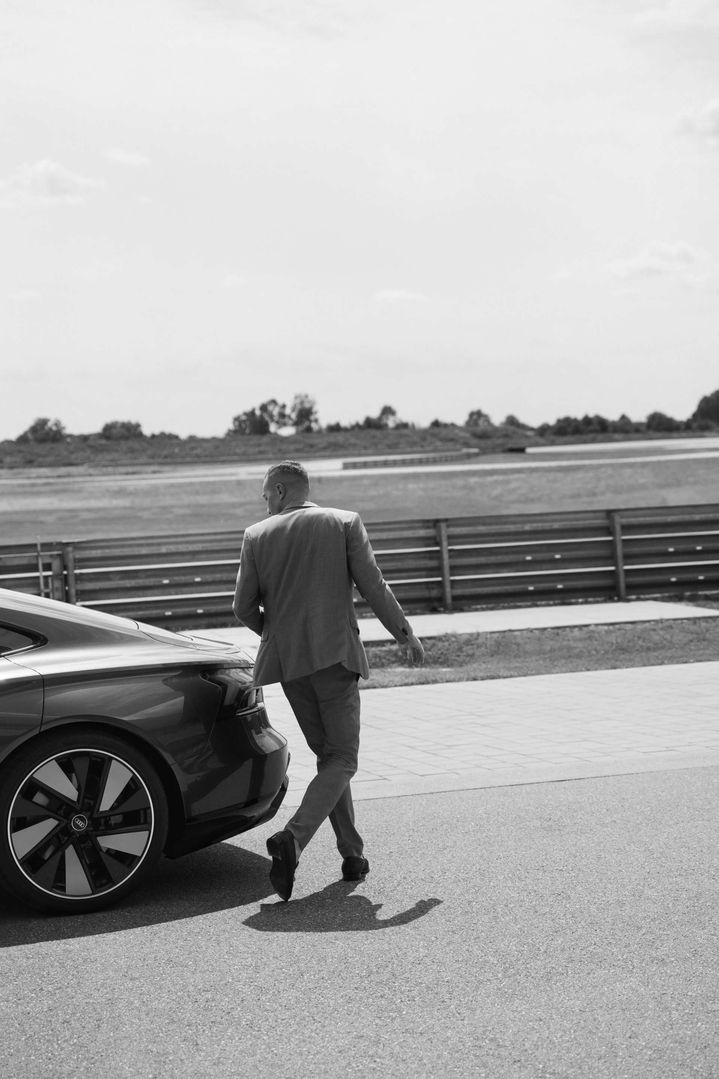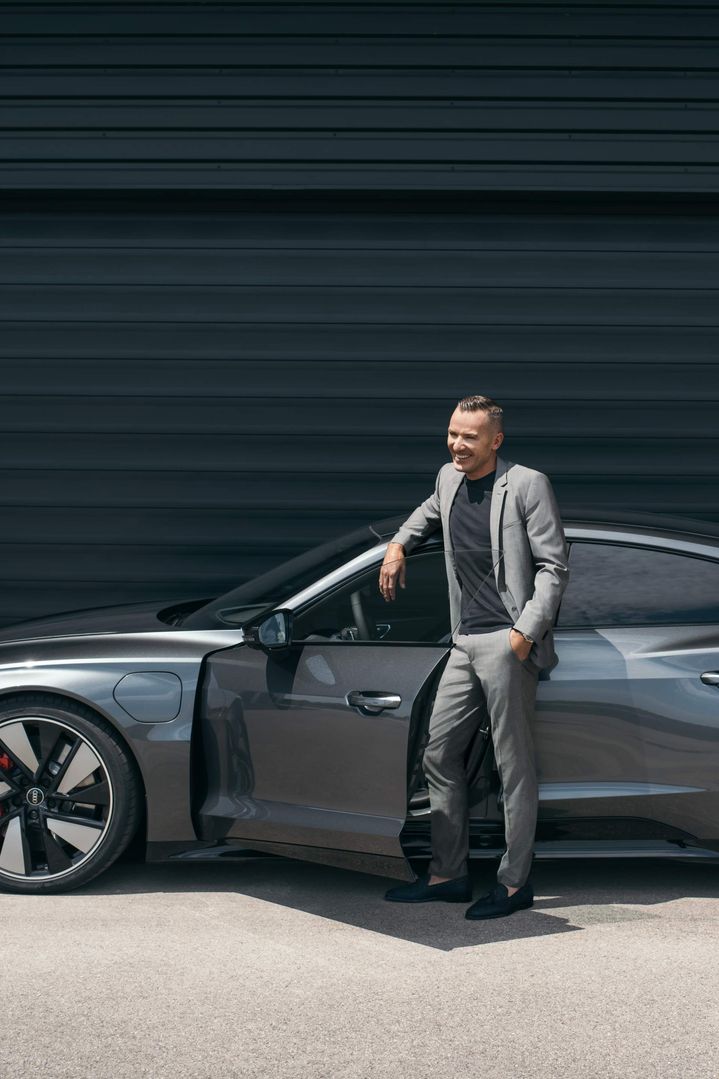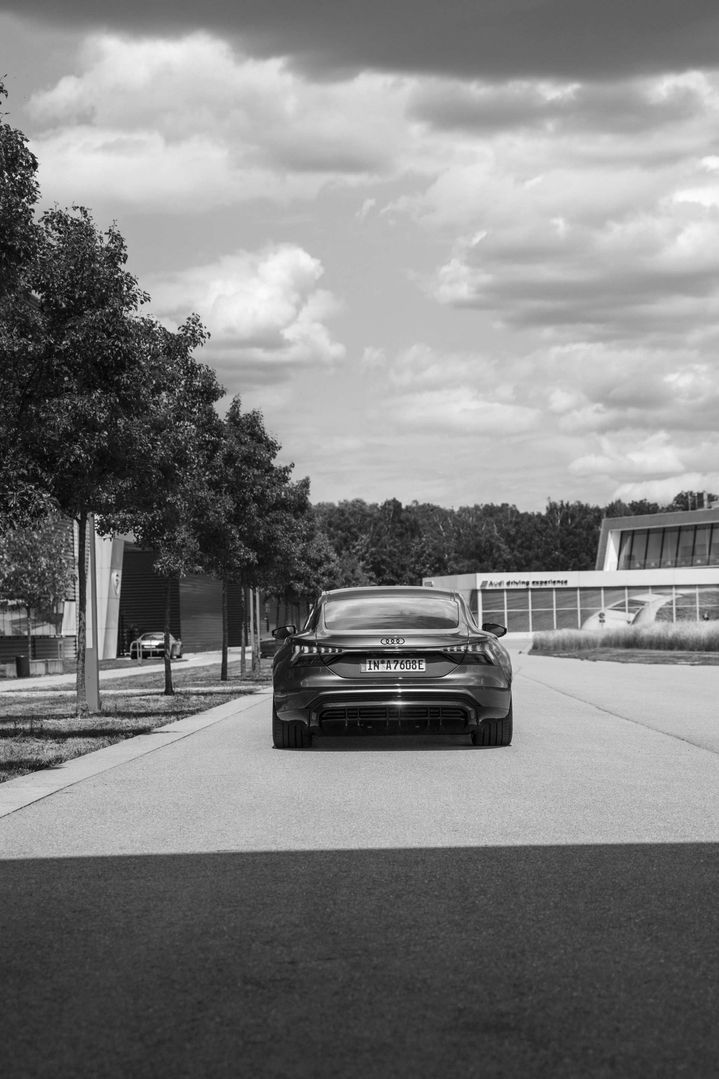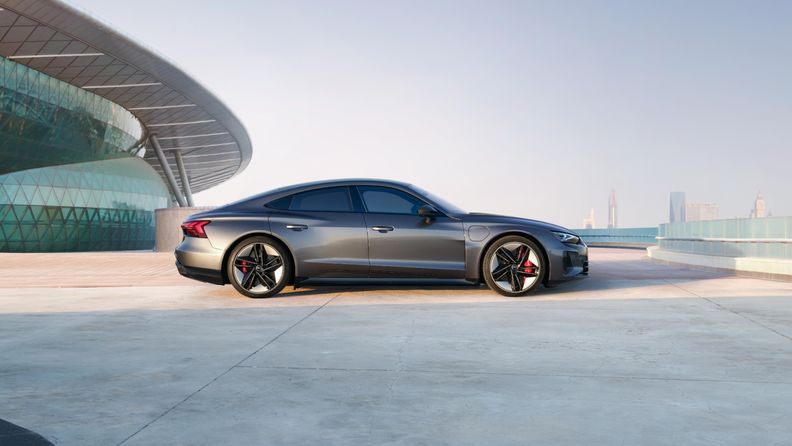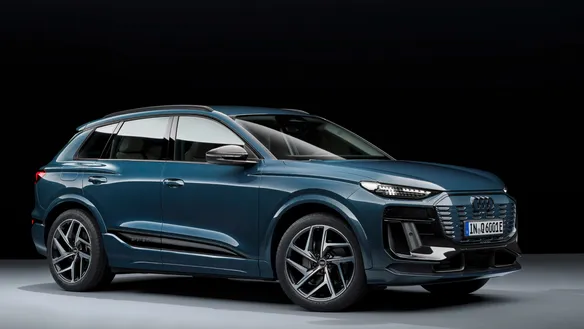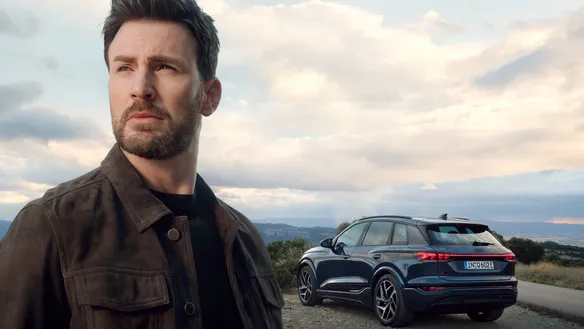Heading into the next era of electrification
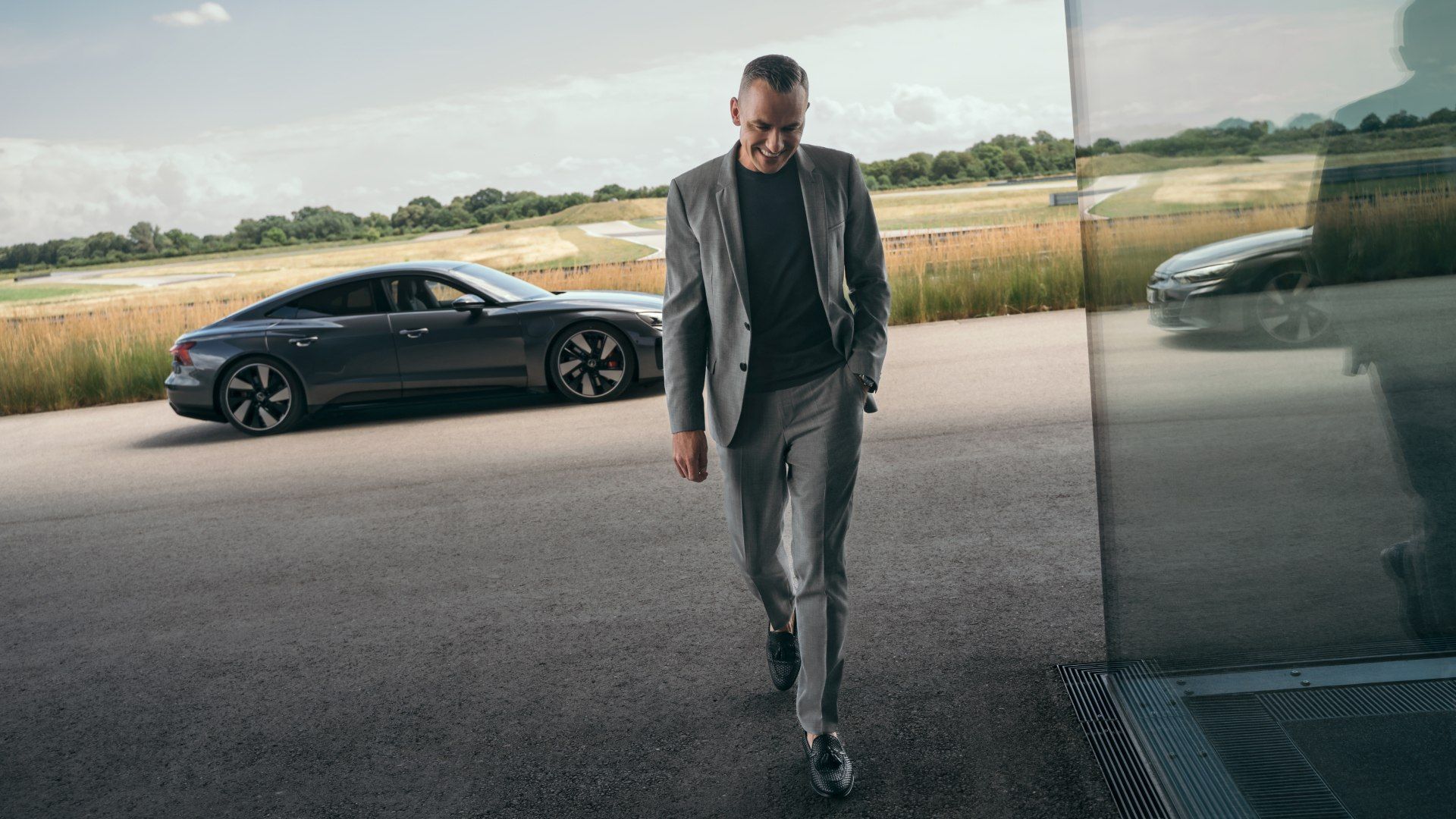
As Henrik Wenders, Head of the Audi brand, steps out of his Audi e-tron GT, he’s smiling. “I’m always in a good mood and very relaxed when I’m taking this car on the road,” he reveals. Because he just needs to take a look at the performance data and the design of the all-electric Gran Turismo. “These dynamics, aesthetics and this calmness and sovereignty,” he enthuses. “I find it’s the perfect e-vehicle.” Henrik Wenders knows the Audi e-tron GT inside and out and was one of few who were given the chance to thoroughly test it in daily life before it went on sale. Plus, electric mobility has been part of his personal lifestyle for a decade now. At the IAA Mobility in Munich, he will be talking about this – about the opportunities and challenges of electrified mobility, that is now entering a new phase at Audi. Which brings us to our interview...
Henrik, you’ve been driving only electric vehicles for over a decade. Was there some kind of initial spark, a key moment, for you to make the switch to electric?
It wasn’t so much a single moment as my fascination with technology. I’ve always been fascinated by how technology can enhance the quality of life and create added value. And, you know, ten years ago it was already a known fact that the use of electric motors could reduce local emissions in driving mode. It became clear to me that you have to rethink individual mobility, and I would describe myself as a person who is comfortable with rethinking things.
So, is electromobility something you have to get involved with, something you have to approach holistically?
I can only recommend doing just that. Driving locally with zero CO₂ emissions is only one benefit. Once you have the option of charging green electricity, you just feel good about electromobility, at least I do. When I made the switch to electric ten years ago, I found it very important to be able to generate my own green electricity via a photovoltaic system to charge my car. I still do that today, and I think it’s wonderful. Besides the many technical aspects, it is important to communicate this good feeling you get about electromobility.
Audi e-tron GT quattro: Power consumption (combined) in kWh/100 km: 21.6–19.6CO₂ emissions (combined) in g/km: 0CO₂ emission class: A
Audi e-tron GT quattro: Power consumption (combined) in kWh/100 km: 21.6–19.6CO₂ emissions (combined) in g/km: 0CO₂ emission class: A
“In the first half of this decade we need to get people excited about electromobility.”
How has electromobility changed since then?
Well, back in the day, we faced a lot of hurdles, of course, that no longer exist in the same form today. The charging infrastructure was much worse, and the range and charging performance of the vehicles were still a real issue. Especially in winter, when you had to decide whether to use energy for range or for heating even my determination was put to the test time and time again. But, you know, the first steamships could hardly carry passengers because they were full of fuel to fire the engines. Every technology goes through phases that follow an s-shaped curve. And at the beginning, in the development phase, this curve starts out very flat.
Why is Audi so determined to drive change?
After the age of industrialisation we are now entering an age of decarbonisation. And decarbonisation is of the greatest social relevance. At Audi, we are therefore taking responsibility along the entire value chain of our products. We are currently in what I would call a decade of transformation. We are transforming from local to global, from offline to online, and from a mobility dominated by the internal combustion engine to an automobile that is increasingly becoming a smart device – running on electricity, of course. In the first half of this decade, we need to get people excited about this form of electromobility and overcome reservations.

What do you think, where do we stand today?
A lot has been done. For example, our customers currently have access to more than half a million charging points in 27 European countries via the Audi Charging Service alone. The Audi e-tron GT offers a range of 400 to 500 kilometres, depending on how you drive, and charges with up to 270 kW at high-power charging points. This is reason enough to convince people of the benefits of electromobility. For me, electromobility represents a real win-win situation.
Why is that?
Mobility has always had something to do with experiences, with positive experiences by being on the road. Electromobility is a great opportunity for all of us to maintain this level of experience, even to increase it thanks to the possibilities the growing digitisation offers. At the same time, by consistently ensuring sustainability along the entire value chain, it can make a significant contribution to decarbonisation. We do this not only for our customers, but out of a sense of responsibility to society. A company that does not strive for sustainability will not be viable in the long term.
To what extent is the next, new era of electromobility now starting for Audi?
Audi has taken a very clear position, which I think is great: From 2026, we will only launch fully electric vehicles and by then we will already have ten fully electric e-tron models in our portfolio. We will soon be building models on a completely new technical platform, the Premium Platform Electric (PPE). In terms of range, e-performance and interior experience, we are thus already transitioning into a new generation of e-vehicles from Audi.
“The message ‘Future is an attitude’ is also an invitation to be optimistic about the future of mobility.”
Henrik Wenders uses the time during his interview to charge the Audi e-tron GT. “At a fast charging point like this, I can generate a range of over 200 kilometres in about ten minutes with a charging performance of up to 270 kW,” he enthuses. According to him, charging has become more convenient and easier in general. And very soon, as will also be highlighted at the IAA, Audi charge and explore will be offering a new service in the digital charging ecosystem: In the future, people will be able to plan their itinerary around experiences in the myAudi app, and the service will offer corresponding charging points nearby. “In the past years, time spent at the charging point was considered down time, or lost time, rather. With this new service, I would like to extend an invitation to consider and enjoy it as quality time.” Digitisation is key to experience-oriented mobility. And when it comes to digitisation, I immediately think of China ...
You used to live in Shanghai and are a regular visitor to China. How do you perceive mobility there?
I continue to see how excited people are about our products, not least about the Audi e-tron GT, which has just had its market launch there. Let me put it this way: If you want to take a trip to the future of mobility, go to Shanghai. I was just there and was chauffeured through Shanghai’s rush hour in a highly automated vehicle. The driver only had two fingers on the steering wheel sensor. I was really impressed. So, if you want to get to know the world of ICV in the future today, you must travel to China.
The charging time of the battery can vary depending on various factors such as the ambient temperature, the use of other country specific plugs and the use of the preconditioning function (e.g. a remote controlled climate control of the vehicle or the use of the e-tron route planner). When using household plugs, the charging power is limited by the e-tron charging system.
The functions shown are technologies that are currently under development and are not yet available for production vehicles. The future availability of Audi charge and explore as well as individual functions will depend on the legal regulations in the country as well as on the vehicle model and vehicle equipment, the mobile device used and the app settings of the required app. Expected to be available in Germany from winter 2023/2024.
The charging time of the battery can vary depending on various factors such as the ambient temperature, the use of other country specific plugs and the use of the preconditioning function (e.g. a remote controlled climate control of the vehicle or the use of the e-tron route planner). When using household plugs, the charging power is limited by the e-tron charging system.
The functions shown are technologies that are currently under development and are not yet available for production vehicles. The future availability of Audi charge and explore as well as individual functions will depend on the legal regulations in the country as well as on the vehicle model and vehicle equipment, the mobile device used and the app settings of the required app. Expected to be available in Germany from winter 2023/2024.
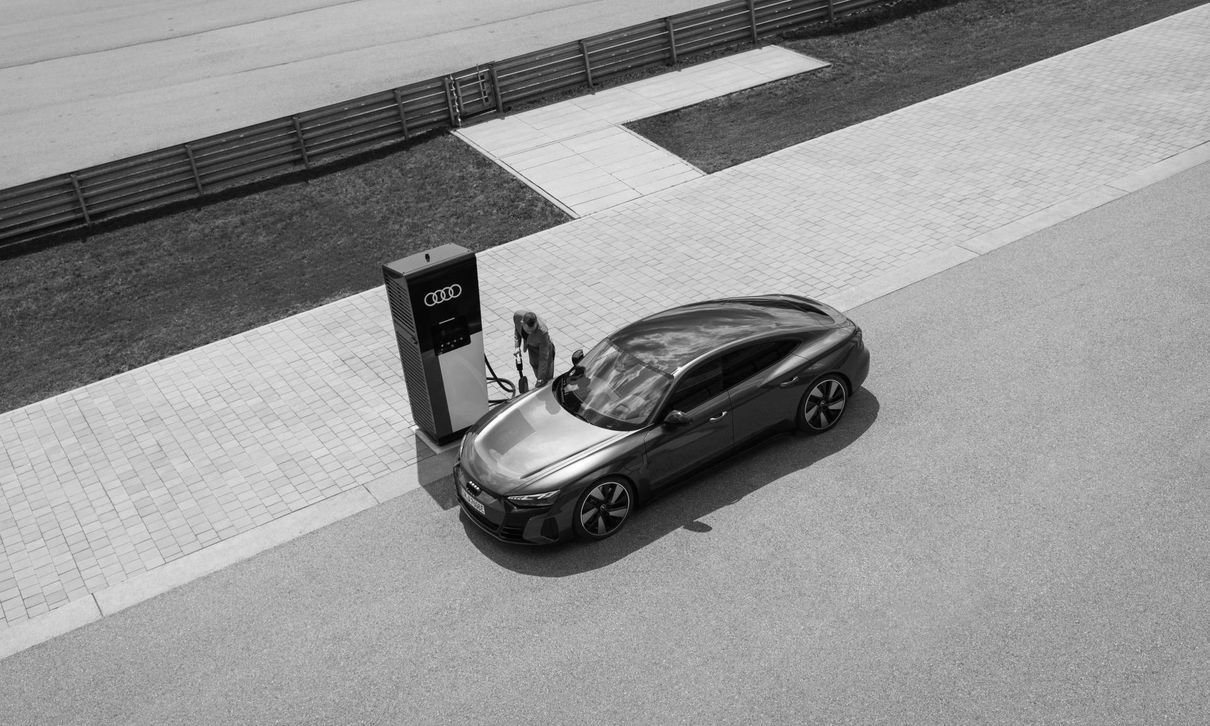
What does ICV stand for?
ICVs, Intelligent and Connected Vehicles, will be highly digitised and automated and of course electric in the second half of this decade of transformation, following the EVs, Electric Vehicles. It is now up to us to define our vehicles. We have already given a sneak peek of the sphere concept cars in the past months. They were developed as a true joint venture between brand and design. The possibilities offered by ICVs literally make it a prerequisite that these two areas go hand in hand in the future. We will increasingly think and act in a user-centric way. So, the question is: What experiences do our customers want when spending time in our vehicles? It’s the brand’s task to curate this endeavour. And that’s exactly what we’re working on right now.
When you look ten years into the future, what do you see?
I see cities without traffic noise, and I hear us laughing about the then-gone worries about the range of e-vehicles or poor charging options. Just as we now smile about the first mobile phones and 2G wireless networks that weren’t really networks but dead spots, really. The amount of liberalisation and democratisation the growing automation and digitisation of our mobility will bring – the increasing independence of space and time. This idea makes me truly optimistic about the future. And that’s exactly what’s behind our message “Future is an attitude”. It is an invitation to look into the future of mobility with optimism and excitement. The immediate and the distant future. The current and the next era. I cannot imagine anything more exciting than shaping this future.


